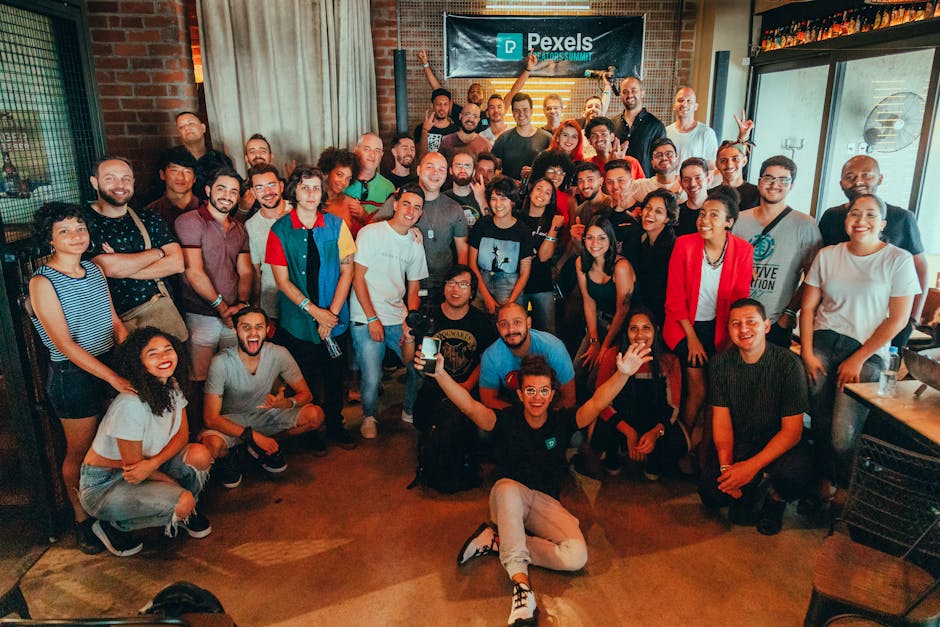The creator economy is a dynamic landscape, offering unprecedented opportunities for individuals to turn their passions into profit. However, despite its immense potential, many creators stumble when it comes to effectively monetizing their work. The journey from content creation to sustainable income is fraught with common pitfalls, often leading to burnout, inconsistent revenue, and ultimately, the abandonment of promising ventures. Understanding these critical mistakes is the first step toward building a resilient and profitable creator business.
This comprehensive guide delves into the top 10 critical mistakes creators make when trying to monetize their work. We will explore the underlying reasons for these errors, provide actionable strategies to overcome them, and highlight how the evolving digital landscape, particularly with the advent of AI and the shift towards experiential value, necessitates a re-evaluation of traditional monetization approaches. Companies like CommuniPass are demonstrating how a focus on practical, experiential value can lead to significantly higher conversion rates, with their challenges converting 5X more than other digital products, underscoring a critical shift in audience expectations.
Mistake 1: Mistaking Vanity Metrics for Success
One of the most pervasive mistakes critical mistakes creators make is fixating on vanity metrics. These are superficial numbers like follower counts, likes, and views that, while visually impressive, often bear little correlation to actual revenue or business growth. Many creators mistakenly believe that a large following automatically translates into significant income, leading them to prioritize quantity over quality in their content strategy.
What are Vanity Metrics and Why are They Misleading?
Vanity metrics are data points that look good on paper but don’t directly reflect business performance or profitability. For creators, this often means celebrating high follower counts or video views without analyzing the engagement depth or conversion potential of that audience. For instance, a creator might have a million followers but struggle to sell a single product, while another with 50,000 highly engaged followers generates substantial revenue.
- Follower Count: A large number of followers doesn’t guarantee active engagement or purchasing power. Many followers can be inactive, bots, or simply not interested in what you’re selling.
- Likes/Reactions: While indicating some level of content appreciation, likes are a low-effort interaction and don’t necessarily translate to brand loyalty or intent to purchase.
- Views: High view counts are great for ad revenue, but if viewers aren’t watching for long or engaging with calls to action, the monetization potential beyond ads is limited.
How to Shift Focus from Vanity Metrics to Actionable Data
To avoid this common error, creators must pivot their attention to metrics that truly impact their bottom line. According to TheCirqle, revenue and monetization success are better predicted by engagement metrics rather than follower count or views alone. They emphasize that quality-weighted engagement (comments, saves, shares weighted by intent) and comment depth are far more predictive of revenue than vanity metrics.
- Track Meaningful Engagement: Focus on metrics like comments, shares, saves, and direct messages. These indicate a deeper connection and interest from your audience.
- Analyze Conversion Rates: How many people click your links? How many sign up for your newsletter? How many make a purchase? These are direct indicators of monetization success.
- Monitor Audience Demographics: Understanding who your audience is (age, location, interests) helps tailor your monetization strategies and product offerings.
Case Study: The Engaged Niche vs. The Broad Audience
Consider two hypothetical creators: Creator A, a lifestyle blogger with 500,000 followers, and Creator B, a niche artist with 50,000 followers. Creator A struggles to convert her broad audience into buyers for her digital products, despite high view counts. Creator B, however, with a highly engaged community passionate about her specific art style, consistently sells out her limited edition prints and online workshops. This illustrates that a smaller, deeply engaged audience is often more valuable for monetization than a massive, disengaged one.

Mistake 2: Ignoring Audience Engagement in Early Stages
Many aspiring creators focus solely on growth hacks and subscriber numbers from day one, neglecting the crucial task of building a deeply engaged community. This is a mistakes critical mistakes strategies that can severely hinder long-term monetization potential. An engaged audience is the bedrock of any successful creator business, as they are the most likely to support your work through purchases, subscriptions, and brand loyalty.
Why is Early Engagement Critical for Monetization?
In the initial stages of a creator’s journey, every interaction is an opportunity to forge a stronger bond with the audience. These early adopters and loyal fans become your most valuable asset. A creator starting from zero subscribers, for example, might only gain 57 in three months but then post a viral video, reaching $1,000 in earnings within five months on YouTube, as highlighted by VidPros. This demonstrates that focusing on watch time, retention, and engagement rates (above 5%) instead of just subscriber count helps build monetization readiness.
- Foundation for Trust: Early engagement builds trust and credibility, making your audience more receptive to your future monetization efforts.
- Feedback Loop: An engaged community provides invaluable feedback, helping you refine your content and offerings to better meet their needs.
- Organic Growth: Engaged audiences are more likely to share your content, leading to organic growth and attracting new, potentially paying, followers.
Strategies for Fostering Deep Engagement
Instead of chasing fleeting trends, creators should prioritize authentic interactions and community building. This involves actively listening to your audience, responding to comments, and creating content that sparks conversation and participation.
- Ask Questions and Solicit Feedback: Encourage comments and direct messages by asking open-ended questions in your content.
- Respond Genuinely: Take the time to respond to comments and messages, showing that you value your audience’s input.
- Create Interactive Content: Polls, Q&A sessions, live streams, and community challenges can significantly boost engagement.
- Build a Dedicated Community Space: Consider platforms like Discord, private Facebook groups, or a dedicated forum where your most engaged fans can connect with you and each other.
The Power of Niche Communities
A common mistakes critical mistakes is trying to appeal to everyone. Instead, focusing on a specific niche allows for deeper engagement. For example, a gaming creator who specializes in retro RPGs will likely build a more passionate and dedicated community than one who covers all video games. This niche audience is more likely to purchase merchandise, subscribe to premium content, or support crowdfunding efforts because their interests align perfectly with the creator’s content.
Mistake 3: Struggling with Revenue Volatility
The creator economy is notorious for its income inconsistency. Many creators, especially those reliant on ad revenue or single income streams, experience significant fluctuations in their earnings. This revenue volatility is a major mistakes critical mistakes solutions that leads to financial stress and often forces creators to abandon their full-time pursuits. According to Whop’s 2024 data, 45% of creators face inconsistent income, highlighting this pervasive challenge.
Understanding the Sources of Income Inconsistency
Revenue volatility stems from several factors inherent to the digital content landscape. A YouTube creator with 500,000 subscribers, for instance, reported monthly earnings fluctuating between $7,500 and $15,000 due to CPM rate changes, seasonal ad demand, and view count volatility, as noted by VidPros. This demonstrates the unpredictable nature of platform-dependent income.
- Seasonal Ad Revenue: Advertising rates often fluctuate throughout the year, with peaks during holidays and dips in quieter months.
- Algorithm Changes: Social media and video platform algorithms are constantly evolving, which can drastically impact content reach and, consequently, ad revenue.
- Audience Engagement Swings: Your audience’s activity can vary, affecting views and interactions, which directly impacts ad impressions and engagement-based earnings.
- Reliance on Single Income Streams: Depending solely on ad revenue, brand deals, or a single product makes creators highly vulnerable to market shifts or platform changes.
Strategies to Mitigate Revenue Volatility
The key to overcoming income inconsistency is diversification and strategic financial planning. Creators need to build a robust monetization portfolio that can weather market fluctuations.
- Diversify Income Streams: Actively pursue multiple revenue channels beyond just ads (e.g., sponsorships, merchandise, digital products, subscriptions).
- Build a Financial Buffer: Save a portion of your earnings during peak periods to cover expenses during leaner months.
- Forecast and Plan: Analyze past income trends to better predict future earnings and adjust your spending accordingly.
- Negotiate Favorable Brand Deals: Seek out long-term partnerships or retainers rather than one-off campaigns to ensure more stable income from sponsorships.
Creator Income Landscape: A Snapshot
The reality of creator income underscores the need for strategic planning. Only 4% of creators earn more than $100,000 annually, making professional creator status rare. Just 12% of full-time creators exceed $50,000, while a significant 46% make less than $1,000, according to The Leap and Inbeat Agency. This data highlights the precarious financial position of many creators and the necessity of addressing revenue volatility head-on.
| Annual Income Bracket | Percentage of Creators | Key Challenge |
|---|---|---|
| Less than $1,000 | 46% | Entry-level, hobbyist income |
| $1,000 – $10,000 | 30% | Part-time, inconsistent income |
| $10,001 – $50,000 | 12% | Emerging full-time, income volatility |
| $50,001 – $100,000 | 8% | Professional, growing stability |
| More than $100,000 | 4% | Top-tier, established professionals |

Mistake 4: Neglecting Multiple Income Streams
A significant mistakes critical mistakes creators make is putting all their monetization eggs in one basket. Relying on a single source of income, such as YouTube ad revenue or a single brand partnership, leaves creators extremely vulnerable to external factors like platform algorithm changes, ad market fluctuations, or the termination of a key deal. While brand partnerships comprise around 70% of creator income, nearly 70% of creators combine multiple revenue streams, such as merchandise, affiliate marketing, and subscriptions, according to Goldman Sachs and Gitnux data. This indicates that while brand deals are significant, diversification is a widespread and necessary practice.
Why Diversification is Non-Negotiable
The creator economy is dynamic and unpredictable. What works today might not work tomorrow. Diversifying income streams provides a safety net, ensuring that if one revenue source declines, others can compensate. This approach is a core mistakes critical mistakes best practices for long-term sustainability.
- Risk Mitigation: Reduces dependence on any single platform or income source.
- Increased Stability: Smoothes out revenue fluctuations, providing a more predictable income.
- Enhanced Growth Opportunities: Each new income stream opens up new avenues for audience engagement and business expansion.
- Audience Segmentation: Allows you to monetize different segments of your audience in ways that best suit their preferences (e.g., free content for casual viewers, premium content for dedicated fans).
Common Income Streams for Creators
Creators have a wide array of options for diversifying their income. The most successful creators often blend several of these to create a robust financial model.
- Brand Partnerships & Sponsorships: Collaborating with brands for sponsored content, product reviews, or ambassadorships.
- Ad Revenue: Income generated from ads displayed on platforms like YouTube, TikTok, or personal blogs.
- Affiliate Marketing: Earning commissions by promoting products or services and driving sales through unique affiliate links.
- Digital Products: Selling e-books, online courses, presets, templates, or digital art.
- Merchandise: Creating and selling physical products like t-shirts, mugs, or custom art.
- Memberships & Subscriptions: Offering exclusive content, community access, or perks through platforms like Patreon, Substack, or a private membership site.
- Direct Sales/Services: Providing coaching, consulting, or custom services related to your niche.
- Crowdfunding/Donations: Receiving direct financial support from your audience through platforms like Buy Me a Coffee or Ko-fi.
Case Study: The Multi-Channel Creator
Consider a fitness creator who initially relied solely on YouTube ad revenue. When YouTube’s algorithm changed, her views and income plummeted. To recover, she diversified: she launched an online fitness course, started a Patreon for exclusive workout plans, partnered with a supplement brand for affiliate marketing, and began selling branded merchandise. This multi-pronged approach not only stabilized her income but also significantly increased her overall revenue, making her business more resilient and sustainable.
Mistake 5: Not Measuring Campaign Effectiveness Rigorously
A critical mistakes critical mistakes in creator monetization, especially concerning brand deals, is the failure to rigorously measure campaign effectiveness. Many creators and even brands focus on superficial metrics like reach or impressions, rather than tangible business outcomes such as ad recall, purchase intent, or conversion rates. This oversight prevents creators from demonstrating their true value and securing better, more frequent partnerships.
Why Rigorous Measurement is Crucial
Without clear data on campaign performance, creators cannot optimize their strategies, justify higher rates, or prove their ROI to potential brand partners. This is a common mistakes critical mistakes trends that limits growth.
- Proving ROI: Demonstrates the direct impact of your content on a brand’s objectives.
- Optimizing Future Campaigns: Data-driven insights help you refine your approach for better results in subsequent campaigns.
- Justifying Rates: Strong performance data allows you to negotiate higher fees and secure more lucrative deals.
- Building Trust: Transparency and proven results build trust with brands, fostering long-term partnerships.
How to Measure Beyond Vanity Metrics
Brands are increasingly sophisticated in their measurement. Creators need to adopt similar rigor. Raptive, a company working with over 5,000 creators, used Nielsen Brand Impact to compare creator websites vs. traditional social and web environments. They found that brands achieved 70% higher ad recall and stronger purchase intent when ads ran on creator websites, proving creator content’s added value for advertisers.
- Track Specific KPIs: Beyond reach, focus on click-through rates (CTR), conversion rates (sales, sign-ups), cost per acquisition (CPA), and brand sentiment shifts.
- Use UTM Parameters: Implement unique UTM codes for all sponsored links to accurately track traffic and conversions originating from your content.
- Request Brand Data: Ask brand partners for performance data on your campaigns, including sales figures or lead generation numbers.
- Utilize Third-Party Tools: Explore tools like Nielsen Brand Impact (if accessible) or other analytics platforms that provide deeper insights into campaign effectiveness.
The Impact of Data on Brand Partnerships
Nearly half (48%) of creators report a lack of communication and clear expectations in brand partnerships, while 37% face poor compensation and misunderstandings, according to Whop. These issues often stem from a lack of clear, measurable objectives and reporting. By providing concrete data, creators can elevate the conversation from “how many views did I get?” to “how much revenue did I generate for you?”

Mistake 6: Overlooking Engagement Rate as a Key Metric
While related to vanity metrics, specifically overlooking the engagement rate is a distinct and critical mistakes critical mistakes creators make. Engagement rate is a normalized metric that provides a much clearer picture of audience quality and content effectiveness than raw follower counts or views. It’s calculated as (Total interactions ÷ total followers) × 100. Despite its importance, Influencer Marketing Hub data shows only 5% of creators focus on engagement rate as their key metric, while 32.5% focus on income and 9% on follower count.
Why Engagement Rate Matters More Than Follower Count
A high engagement rate indicates that your audience is not just present, but actively interacting with your content. This active participation is a strong predictor of their willingness to support you financially, whether through purchases, subscriptions, or direct donations. It’s a fundamental mistakes critical mistakes guide to ignore this.
- Audience Quality: A high engagement rate signifies a healthy, active, and loyal audience, which is far more valuable than a large, passive one.
- Algorithm Favorability: Platforms often prioritize content with high engagement, leading to greater organic reach.
- Brand Appeal: Brands are increasingly looking for creators with strong engagement rates, as it indicates a more effective reach and higher ROI for their campaigns.
- Conversion Potential: Engaged audiences are more likely to click links, make purchases, and convert into paying customers.
Strategies to Boost Your Engagement Rate
Improving your engagement rate requires a strategic approach to content creation and community management. It’s about fostering genuine connections and providing value that encourages interaction.
- Create Highly Relatable Content: Content that resonates deeply with your niche audience will naturally spark more comments, shares, and saves.
- Encourage User-Generated Content (UGC): Prompt your audience to create content related to your brand or niche, and share their contributions.
- Run Contests and Giveaways: These can significantly boost engagement, especially when participation requires comments, shares, or tags.
- Go Live: Live streams offer real-time interaction, allowing you to answer questions, respond to comments, and build a stronger connection with your audience.
- Collaborate with Other Creators: Cross-promotion can introduce your content to new, engaged audiences.
Case Study: The Micro-Influencer Advantage
Micro-influencers (typically 10,000-100,000 followers) often boast significantly higher engagement rates than mega-influencers. While a celebrity with millions of followers might have an engagement rate of 1-2%, a micro-influencer in a specific niche might achieve 5-10% or even higher. Brands are increasingly recognizing this, shifting their budgets towards micro-influencers who can deliver more authentic engagement and better conversion rates, even with a smaller audience. This is a direct result of prioritizing engagement rate over raw follower numbers.
Mistake 7: Underestimating Creator-Consumer Emotional Connection
In an increasingly saturated creator economy, many creators make the mistakes critical mistakes of focusing solely on transactional monetization models without nurturing a deeper emotional connection with their audience. This oversight is particularly detrimental in an era where audiences seek authenticity and practical, experiential value. The shift towards AI-generated content further emphasizes the human element: audiences are looking for experiences, something practical, and a genuine connection that AI cannot replicate. This is why companies like CommuniPass are thriving, with their challenges converting 5X more than other digital products, by focusing on practical, engaging experiences.
The Power of Emotional Connection in Monetization
An emotional connection transforms passive viewers into loyal fans and, crucially, into paying customers. When an audience feels a personal bond with a creator, they are more likely to trust recommendations, invest in products, and support ventures. An insight from a Nielsen + Raptive study highlights that creator platforms drive stronger emotional connections than traditional websites or social media, increasing brand effectiveness.
- Increased Loyalty: Emotionally connected audiences are more loyal and less likely to switch to competitors.
- Higher Conversion Rates: Trust and connection directly translate to a greater willingness to purchase products or services.
- Word-of-Mouth Marketing: Loyal fans become powerful advocates, spreading the word about your content and offerings.
- Resilience to Trends: A strong emotional bond helps creators weather algorithm changes and market shifts, as their audience will actively seek them out.
Strategies for Building Authentic Emotional Bonds
Building an emotional connection is an ongoing process that requires authenticity, vulnerability, and consistent engagement. It’s about sharing your journey, not just your content.
- Share Personal Stories: Be open about your experiences, challenges, and successes. Authenticity fosters relatability.
- Be Vulnerable: Don’t be afraid to show your imperfections or discuss struggles. This humanizes you and creates a deeper bond.
- Engage Beyond Content: Interact with your audience in comments, DMs, and live sessions. Make them feel seen and heard.
- Create Exclusive Community Spaces: Offer private groups or forums where your most dedicated fans can connect with you and each other, fostering a sense of belonging.
- Deliver Experiential Value: As seen with CommuniPass’s challenges, focus on providing practical, interactive experiences rather than just static content.
Case Study: The Creator Who Built a Movement
Consider a creator who started a YouTube channel around sustainable living. Beyond just sharing tips, she shared her personal journey, her struggles with eco-anxiety, and her small victories. She built a community that felt like a supportive family, regularly hosting live Q&As and even organizing local meetups. When she launched her line of eco-friendly products, her audience didn’t just buy products; they invested in her mission, leading to overwhelming success and a loyal customer base that transcended mere transactions.

Mistake 8: Lacking Data-Driven Creator Partner Selection
For creators seeking to monetize through collaborations, a significant mistakes critical mistakes is failing to approach partner selection with a data-driven mindset. This applies both to creators choosing brands to work with and, conversely, to brands choosing creators. Many creators jump at any brand deal, regardless of fit or potential, while brands often rely on superficial metrics. This leads to ineffective campaigns and missed monetization opportunities. Expert advice from TheCirqle emphasizes that successful teams use shared scoreboards with early intent signals to scale creator partnerships confidently, rather than chasing large but less engaged audiences.
Why Data-Driven Selection is Essential for Monetization
A strategic approach to partnerships ensures alignment, maximizes impact, and ultimately drives better monetization outcomes. This is a key mistakes critical mistakes strategies to avoid.
- Brand Alignment: Ensures the brand’s values and products align with your audience’s interests, leading to more authentic and effective promotions.
- Audience Fit: Guarantees that the brand’s target demographic matches your audience, increasing the likelihood of conversions.
- Performance Prediction: Data helps predict which partnerships are most likely to yield positive results, saving time and effort.
- Negotiation Leverage: Understanding your audience’s value and past performance data strengthens your position in negotiations.
How to Implement Data-Driven Partner Selection
Creators need to act like businesses, evaluating potential partnerships based on concrete data and strategic fit, not just immediate financial gain.
- Define Your Ideal Partner: Clearly outline the type of brands that align with your niche, values, and audience.
- Analyze Audience Demographics: Use your analytics to understand your audience’s age, location, interests, and purchasing power. Share this data with potential partners.
- Evaluate Brand’s Past Campaigns: Research how the brand has worked with other creators. Look for transparency, fair compensation, and clear communication.
- Assess Engagement Metrics: For brands approaching you, provide them with your engagement rate, click-through rates on past sponsored content, and conversion data if available.
- Use a Partnership Scorecard: Create a simple scoring system to evaluate potential partners based on factors like brand fit, audience overlap, compensation, and campaign objectives.
Case Study: The Strategic Niche Partnership
A gaming creator specializing in indie games was approached by a major AAA game studio. While the offer was lucrative, the creator realized their audience primarily valued unique, independent titles. Instead, they sought out a partnership with a smaller indie game developer whose upcoming release perfectly matched their audience’s interests. Despite a lower initial payout, the authentic promotion led to massive engagement, high conversion rates for the game, and a long-term, highly profitable relationship with the indie studio, proving that strategic fit driven by data beats large, misaligned deals.
Mistake 9: Failing to Adapt to Platform Monetization Stages
Many creators make the mistakes critical mistakes of not understanding or adapting to the specific monetization thresholds and stages of different platforms. Each platform has its own set of rules, requirements, and optimal strategies for earning revenue. Failing to recognize these nuances can lead to frustration, stalled growth, and missed income opportunities. For example, YouTube’s monetization stages illustrate how creators transition from hobbyists to professionals, facing income volatility and needing to adjust their content strategy accordingly.
Understanding Platform-Specific Monetization
Platforms like YouTube, TikTok, Instagram, and Twitch each offer distinct pathways to monetization, with varying requirements for eligibility and different revenue models. Over-reliance on platform algorithms is a major risk factor, with 77% of creators worried about platform income reliance and 70% fearing algorithm changes could severely impact their livelihoods, according to The Leap.
- YouTube: Requires 1,000 subscribers and 4,000 watch hours (or 10 million Shorts views) for ad monetization. Super Chat, Memberships, and Merchandise Shelf have additional requirements.
- TikTok: Monetization through the Creator Fund, LIVE Gifts, and Creator Marketplace (for brand deals) often depends on follower count, view thresholds, and engagement.
- Instagram: Primarily monetizes through brand partnerships, affiliate links, and shopping features. Badges for Live, Subscriptions, and Bonuses are emerging.
- Twitch: Affiliates and Partners can earn through subscriptions, Bits, and ads, with specific streaming hour and follower count requirements.
Strategies for Adapting to Platform Stages
Creators must proactively learn and adapt to each platform’s monetization ecosystem. This involves understanding the thresholds, optimizing content for specific revenue streams, and diversifying across platforms to mitigate risk.
- Research Platform Requirements: Before investing heavily, understand the specific criteria for monetization on your chosen platforms.
- Optimize Content for Each Platform: What works on TikTok might not work on YouTube. Tailor your content format, length, and style to suit the platform’s audience and monetization model.
- Monitor Algorithm Changes: Stay updated on platform algorithm changes and adjust your content strategy accordingly to maintain reach and visibility.
- Leverage Platform-Specific Tools: Utilize features like YouTube’s Super Chat, Instagram’s shopping tags, or Twitch’s channel points to maximize in-platform earnings.
- Build an Off-Platform Audience: Direct your audience to an email list or personal website to reduce reliance on platform algorithms and create a direct monetization channel.
Case Study: The Twitch Streamer’s Evolution
A gamer started streaming on Twitch, initially struggling to gain traction. They focused on consistently streaming and engaging with their small audience to meet the Affiliate requirements (50 followers, 8 hours streamed, 7 unique days, 3 average viewers). Once an Affiliate, they encouraged subscriptions and Bits, building a stable base. As their audience grew, they aimed for Partner status, which unlocked more ad revenue and exclusive features. Simultaneously, they started uploading highlights to YouTube, diversifying their content and income, demonstrating a clear understanding of platform progression and adaptation.

Mistake 10: Missing the Role of Sponsored Content in Conversion
The final critical mistakes critical mistakes creators often make is underestimating the power of sponsored content as a direct conversion driver, viewing it merely as a source of quick cash rather than a strategic monetization tool. Many creators fail to integrate sponsored messages authentically or to optimize them for sales, missing out on their full potential. Over 90% of marketers say sponsored creator content outperforms organic brand content in engagement and conversions, according to Inbeat Agency, underscoring its immense value when executed correctly.
Why Sponsored Content is More Than Just an Ad
When done right, sponsored content leverages the creator’s trust and influence to drive tangible results for brands, which in turn leads to more and better-paying opportunities for the creator. It’s a fundamental mistakes critical mistakes strategies to overlook its conversion potential.
- Trust and Authenticity: Audiences trust creators more than traditional ads, leading to higher engagement and conversion rates.
- Niche Targeting: Creators offer direct access to highly specific, engaged audiences who are pre-disposed to be interested in relevant products.
- Storytelling Power: Creators can weave brand messages into compelling narratives, making them more memorable and persuasive.
- Direct Conversion Potential: With clear calls to action and trackable links, sponsored content can directly drive sales, sign-ups, or leads.
Strategies for Maximizing Sponsored Content Conversions
To turn sponsored content into a powerful conversion engine, creators need to be strategic, authentic, and data-driven in their approach.
- Choose Authentic Partnerships: Only collaborate with brands and products you genuinely believe in and that align with your content and audience. Inauthenticity is quickly detected and damages trust.
- Integrate Naturally: Weave the sponsored message seamlessly into your regular content style. Avoid jarring transitions or overly salesy language.
- Provide Clear Calls to Action (CTAs): Tell your audience exactly what you want them to do (e.g., “Click the link in my bio,” “Use code [CREATORNAME] at checkout”).
- Educate Your Audience: Don’t just promote; explain the benefits of the product or service and how it solves a problem for your audience.
- Track and Report Results: Use unique links, discount codes, or landing pages to track conversions. Provide brands with detailed performance reports to demonstrate ROI.
- Negotiate Performance-Based Deals: As you gain experience, consider negotiating deals that include bonuses for exceeding conversion targets, aligning your incentives with the brand’s success.
Case Study: The Beauty Influencer’s Authentic Integration
A beauty influencer known for her honest product reviews partnered with a skincare brand. Instead of a simple product showcase, she integrated the product into her daily routine, showing its effects over several weeks and documenting her genuine experience. She explained the science behind the ingredients and offered a discount code. Her authentic approach led to a significant surge in sales for the brand and a high conversion rate, resulting in a long-term partnership and demonstrating the power of trust-based sponsored content.
Frequently Asked Questions (FAQ)
How do I start monetizing my content effectively as a new creator?
Start by focusing on building a deeply engaged niche audience rather than chasing large follower counts. Prioritize watch time and genuine interactions. Once you have a loyal base, explore diversified income streams like affiliate marketing or digital products that align with your audience’s needs, rather than solely relying on ads.
What are the most common monetization mistakes critical mistakes for content creators?
The most common mistakes critical mistakes include focusing on vanity metrics, neglecting audience engagement, relying on single income streams, poor campaign measurement, ignoring engagement rate, lacking emotional connection, not using data for partnerships, failing to adapt to platform stages, and missing the conversion potential of sponsored content.
Why should creators diversify their income streams?
Creators should diversify to mitigate financial risk and achieve income stability. Relying on a single source, like ad revenue, makes you vulnerable to platform algorithm changes or market fluctuations. Multiple streams (e.g., brand deals, digital products, subscriptions) create a financial safety net and open new growth opportunities.
When is the right time to start seeking brand partnerships?
Start seeking brand partnerships once you have a clear niche, a consistent content schedule, and a demonstrable engaged audience, regardless of raw follower count. Brands prioritize engagement and audience fit over sheer numbers. Focus on building trust and providing value to your audience first, then approach brands that align with your content.
How can I measure the true effectiveness of my sponsored content?
Measure effectiveness beyond vanity metrics by tracking specific KPIs like click-through rates (CTR), conversion rates (sales, sign-ups), and return on ad spend (ROAS). Use unique UTM parameters for all links and request performance data from brands. Focus on demonstrating tangible business outcomes, not just impressions.
What role does audience engagement play in creator monetization?
Audience engagement is paramount. High engagement indicates a loyal, active community more likely to convert into paying customers. It also signals to platforms that your content is valuable, boosting organic reach, and makes you more attractive to brands seeking effective partnerships. It builds trust and fosters long-term relationships.
How do AI content tools impact creator monetization strategies?
AI content tools can automate aspects of content creation, increasing efficiency. However, they also raise concerns about content saturation and authenticity. Creators must adapt by focusing on unique perspectives, experiential value, and building strong emotional connections that AI cannot replicate. The human element becomes even more critical for monetization.
What is the “monetization barrier” for creators, and how can it be overcome?
The monetization barrier often sits around $15,000 annual revenue, below which income plateaus due to a lack of structured monetization strategies. To overcome it, creators need to implement diversified income streams, focus on converting influence into consistent revenue, and actively seek out better brand deals and audience scalability.
Why is it important to understand audience willingness to pay?
Understanding audience willingness to pay is crucial for pricing products and services effectively. It helps creators develop offerings that their specific audience values and is prepared to purchase. Without this insight, creators risk underpricing their work or creating products no one wants to buy, leading to missed monetization opportunities.
How can creators avoid burnout while trying to monetize?
Avoiding burnout requires strategic workload management and setting realistic expectations. Diversify income to reduce pressure on single revenue streams, automate repetitive tasks, delegate where possible, and prioritize self-care. Remember that sustainable monetization is a marathon, not a sprint, and consistent effort over time is key.
What are the risks of over-relying on social media platforms for income?
Over-reliance on social media platforms carries significant risks, including vulnerability to algorithm changes, platform policy shifts, and potential account suspension. It also means you don’t own your audience data. Building an off-platform audience (e.g., email list) and diversifying income streams are crucial to mitigate these risks.
How can creators improve their negotiation skills for brand deals?
Improve negotiation skills by understanding your value, knowing your audience’s demographics and engagement rates, and having clear performance data from past campaigns. Research industry rates, be confident in your worth, and don’t be afraid to ask for fair compensation, including performance-based incentives or long-term retainers.
What’s the difference between vanity metrics and actionable metrics?
Vanity metrics (e.g., follower count, likes) look good but don’t directly correlate to business success. Actionable metrics (e.g., engagement rate, conversion rate, click-through rate) directly reflect audience quality, content effectiveness, and monetization potential. Focus on actionable metrics to make informed decisions and drive revenue.
Why is building an email list important for creators?
Building an email list provides a direct communication channel with your audience that you own, independent of social media platforms. It’s crucial for long-term monetization as it allows you to directly promote products, services, and content without relying on algorithms, fostering a more reliable and intimate connection with your most dedicated fans.
How can creators adapt to the evolving creator economy with AI and saturated markets?
Adapt by focusing on unique value propositions, deep audience connection, and providing experiential content that AI cannot replicate. Leverage AI tools for efficiency, but emphasize your authentic voice and human touch. Continuously learn, diversify, and be agile in responding to market shifts and new monetization opportunities.
Conclusion
Navigating the creator economy requires more than just talent; it demands strategic thinking, adaptability, and a keen understanding of monetization principles. The 10 critical mistakes critical mistakes creators often make—from fixating on vanity metrics to neglecting diversified income streams and failing to measure campaign effectiveness—can severely impede their journey toward sustainable income. The landscape is rapidly evolving, with AI reshaping content creation and audiences increasingly seeking practical, experiential value over passive consumption, as exemplified by the success of platforms like CommuniPass.
By consciously avoiding these common pitfalls, creators can build resilient businesses, foster deeper connections with their audiences, and unlock their full earning potential. The key lies in prioritizing genuine engagement, embracing data-driven decision-making, diversifying revenue streams, and continuously adapting to the dynamic demands of the digital world. Success in the creator economy isn’t just about creating great content; it’s about building a smart, sustainable business model that stands the test of time.








